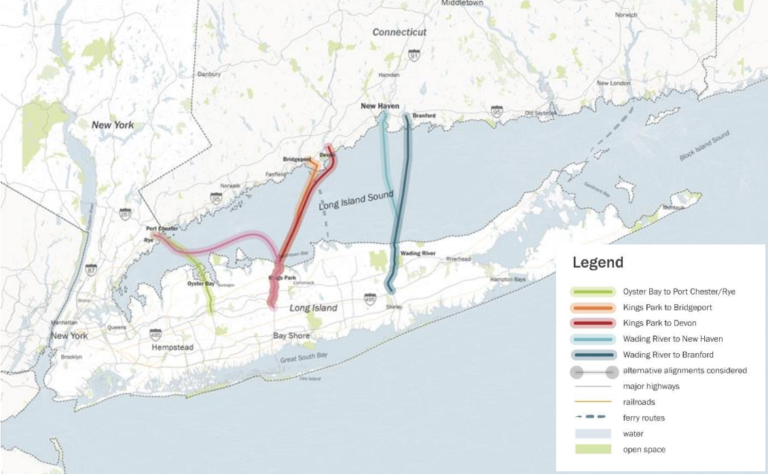
Like so many similar projects before it, a bridge/tunnel that would have crossed the Long Island Sound has been canceled.
In a statement on Thursday, the state’s Acting Transportation Commissioner Paul Karas said the state Department of Transportation would not move forward with the project.
“After a careful review of a variety of considerations pertaining to the project, NYSDOT has decided not to move forward with it at this time,” he said.
A study released last December by Montreal consulting firm WSP examined three possible routes across the Sound using either a bridge, tunnel, or combination of the two: on the east end of the island, from Wading River to New Haven and Branford; in the central part of the island, from Kings Park to Bridgeport and Devon; and on the western end, from Oyster Bay to Rye/Port Chester.
According to the study, the route between Oyster Bay and Rye was preferred because it best accomplished the project’s goals of improving mobility, promoting economic growth, and developing cost-effective transit while limiting environmental impact.
While that route was the shortest distance of the three, it was also the most expensive with a price tag ranging from $31.5 billion to $55.4 billion.
The study estimated that the Oyster Bay route would have 86,400 daily riders if the toll was $20 and that the route would generate at least $520 million annually in toll revenue.
The statement from Karas did not give a reason why the project was canceled, but in addition to the high cost, the state would have faced strong opposition from North Shore residents.
Possible opposition to the plan began to spring up earlier this year.
During the March meeting, Flower Hill Trustee Frank Genese said the village was working on a statement with other communities opposing the project.
He did note, however, that it was unlikely the project would ever happen.
“God knows how many times in my lifetime they’ve [proposed] a bridge or tunnel,” he said.
This combination of price and local opposition explain why previous attempts have failed.
There were eight prior attempts to build a link across the Sound, according to the WSP study.
The earliest attempt was a proposal by Sen. Royal Copeland in 1938. Perhaps the closest the project came to happening was in 1965 when a $150 million bridge was proposed between Rye and Oyster Bay.
The brainchild of Robert Moses, it initially had the support of Gov. Nelson Rockefeller until he withdrew his support due to local opposition, bond issues, and environmental concerns.
Reach reporter Luke Torrance by email at [email protected], by phone at 516-307-1045, ext. 214, or follow him on Twitter @LukeATorrance.







I like infrastructure, particularly oversea bridges and underwater bored tunnels. But for me, this project being canceled isn’t a disappointment. For me, the disappointment is that regardless if such a bridge or tunnel were built, it would not be from the east end of Long Island, to Rhode Island. A route that would make Long Island a more local tourist destination and even create a shortcut for cargo trucks from either Connecticut, OR Rhode Island. For RI and CT, Long Island would not only be a destination spot, but also for an exciting tour drive like the Florida Keys or Nova Scotia. And travelers would not reach a dead end. They could enter one end of Long Island and leave through the other end. And it would be less costly, faster and more satisfying to travelers to no longer having to choose between a long way west to reach Long Island, and a ferry as the shortcut. Hotels could even be built for tourists from RI and CT.
I like that this article brings up the 1965 attempt to build a bridge from Rye to Osyter Bar that was spearheaded by Moses. One thing that was not mentioned, however, is that this bridge would have required the addition of twelve extra lanes to the L.I. Expressway in order to accommodate all of the extra bridge traffic. I still stand quite firmly by the notion that new Sound crossings create bigger traffic woes instead of alleviating congestion. Congestion only became worse when the Bronx-Whitestone and Throgs Neck bridges were built, and I feel that this trend would only continue with a new crossing.
Macrcell’s analysis above makes no sense.
They should do it.
Its also curious that one should watch the film “Motherless Brooklyn” or read the book “Power Broker” by Robert Caro to get another take on why these projects succeed or fail.